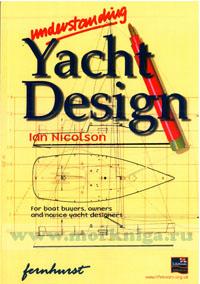Understanding Yacht Design. Понимание дизайна яхты
This book is short and simple. Chapters have been reduced to basics and liberties have been taken, so that anyone can start designing quickly and easily.
Because designing is such a big subject, many problems have been eliminated by using simple "rules of thumb". Subjects like stability, speed and powering have been made understandable by substantial simplification.
A yacht designed using this book should look prettier than some of the products of boat factories. She could well be faster, and she should have that most valuable of all characteristics - she will have been designed lovingly by someone who does not constantly seek the cheapest way of making each component. Designs which are heavily influenced by accountants are seldom a success.
If a boat is ugly she will not get the love, care and maintenance she needs. She is unlikely to last long or give her owners and crew a full measure of pleasure. The way to learn how to design beautiful craft is to look at the work of the designers whose work has lasted.
Содержание
Designing Made Easy
Part1- How to Begin
Chapter1- Good-looking Craft
Chapter 2-Getting Started
2.1 Equipment for drawing
Chapter 3 - Honing the Specification
3.1 The first list - Essentials
3.2 The second list - Would love to have...
3.3 The third list - Your luxuries
3.4 Sources of information
Chapter 4 - Sketching the Layout & Appearance
4.1 Making a start
4.2 Drawing the grid & the rationale for it
4.3Selecting the draught
4.4 Ratio of canoe body to keel
4.5 Ratio of the height of the cabin sole to boat length
4.6 Headroom
4.7 The lid
Part2- Designing the Yacht
Chapter 5 - Drawing the Lines
5.1 The lines - waterlines, buttocks, sections & diagonals
5.2 Making the lines fluent
5.3 Choice of scale
5.4 Laying out the design
5.5 Families of interrelated curves and lines
5.6 Displacement calculations
5.7 Simpson's Rule
5.8 Centre of buoyancy
Chapter 6 - Weight & Displacement
6.1 Archimedes' Law & displacement
6.2 Ensuring hull volume below LWL equals total weight of the craft
6.3 Cubic Numbers
6.4 Calculating a craft's total weight
6.5 Longitudinal Centre of Gravity
Chapter 7 - How Will She Perform?
7.1 The basic speed formula
7.2 Speed in light winds
7.3 Windward performance
7.4 Planing - at least partially
7.5 How is she going to perform?
Chapter 8 - Sail Plan
8.1 Centre of Lateral Resistance
8.2 Calculating the sail area required
8.3 Drawing the sail plan
8.4 Calculating the Centre of Effort
Chapter 9 - Construction
9.1 Construction drawings and detailing
9.2 Some essential principles of construction
9.3 Fibreglass construction
9.4 Wood construction
9.5 Steel construction
9.6 Aluminium construction
9.7 Summing up
Chapter 10 - Engines
10.1 Factors involved in your decisions
10.2 Propellers
10.3 Prop shafts & engine positioning
10.4 The exhaust, silencer and controls
10.5 Decisions to be made "at ship"
Chapter 1 1 - The Cabin or Accommodation Plan
11.1 Using one metre intervals
112 Design with the crew's safety in mind
I 1.3 Keep it simple
11.4 Implications of boat motion for the layout 115 Bulkheads
11.6 Standardise components
Chapter 12 - The Deck Plan
12.1 How to set out the drawing
12.2 Some practical differences between cruisers & racers
12.3 Forehatches need some thought
12.4 Ensuring adequate ventilation
12.5 Coachroof details
12.6 A safe working deck
12.7 Making the job a little easier
12.8 Of compasses & cockpits
12.9 Checking the design
Chapter 13 - Costing a Design
13.1 Underlying principles
13.2 By direct comparison
13.3 The Five Foot Rough Rule
13.4 Adding up all the prices
13.5 Costs & overheads - the boat builder's perspective
13.6 The Three Times Materials Rule
13.7 Some of the special factors to affect a costing
Part 3 - Making Alterations to a Design
Chapter 14 - Changing the Sail Plan
14.1 Reducing the sail area
14.2 Increasing the sail area
14.3 Altering weather helm
14.4 Some serious consequences of moving a mast
Chapter 15 - Designing an Alteration
15.1 Proper drawings are important
15.2 A new deck layout
15.3 A new cabin plan
15.4 Some useful pointers...
15.5 The basic rules for designing alterations
Part 4 - To Use Computer Aided Design or Not?
Chapter 16 - Computer Aided Design
16.1 Arguments for and against CAD
16.2 The kit
16.3 Printing from a disk
16.4 The software needed
16.5 Costs are coming down
16.6 Some real advantages
Glossary
Bibliography

 Дизель на яхте. Практическое пособие
Дизель на яхте. Практическое пособие  Навигация на яхте
Навигация на яхте  Английские морские навигационные пособия
Английские морские навигационные пособия